Dell UltraSharp U2711: Quality has a Price
by Jarred Walton on January 22, 2010 2:00 AM EST- Posted in
- Displays
Dell U2711 Color Quality
We'll start with a look at the color quality of the U2711, broken down into two areas: Color gamut and color accuracy (i.e. Delta E). We'll start by explaining the former. Color gamut refers to the ability for a display to represent all of the colors in a defined selection of colors. In this case, we use the Adobe RGB standard to define the base gamut, and we measure the percentage of that standard that a display is able to cover - higher being better.
Delta E is the difference between a requested color and the color that actually appears on the display, with lower being better - i.e. the displayed color doesn't have a large delta relative to what was requested. If a display has perfect color accuracy, Delta E will be 0.0; in practice, anything less than 1.0 is nearly perfect and no one will notice the difference. A Delta E of 2.0 or less is the desired result after calibration, meaning no one color measures higher than 2.0 on our standard 24 color palette. Such a result would be fit for use in any professional imaging environment. Finally, while Delta E of around 4.0 is visible to the naked eye, it's really a question of reference points; if you don't have something better nearby and you're not going to print or view content on other media, a result where all colors measure 4.0 or less is very good.
So how does the U2711 do in these areas? First let's look at the charts, and then we'll discuss what they mean. We used the Graphics and Adobe RGB setting on the U2711, with brightness set at 36% (~200nits) and contrast at the default 50%.
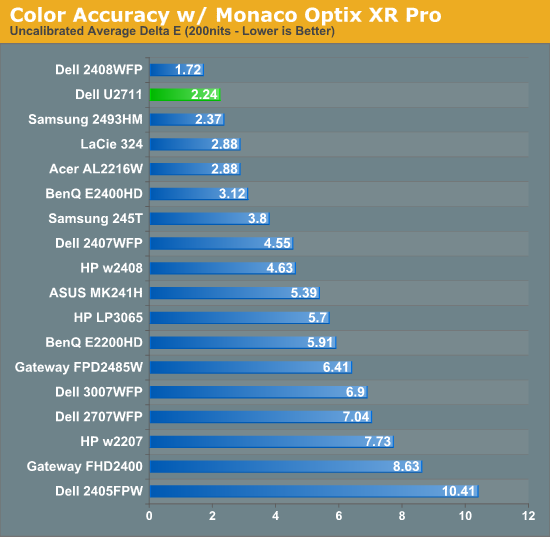
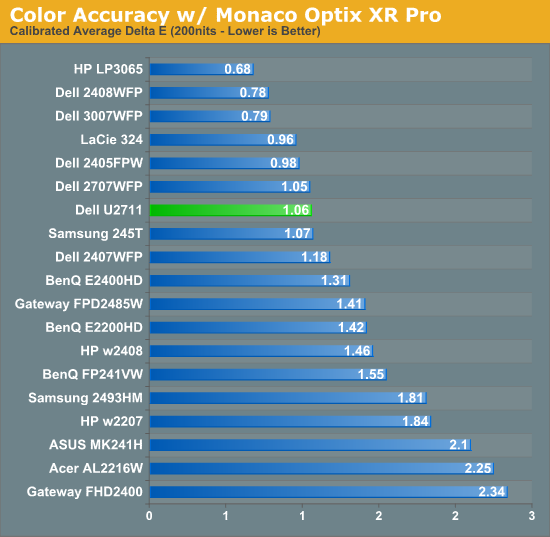
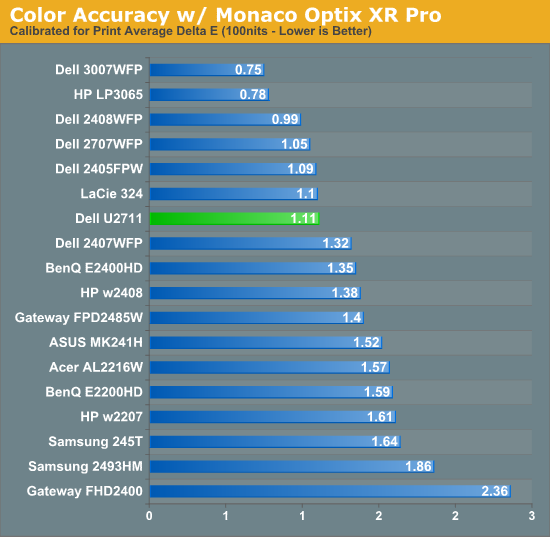
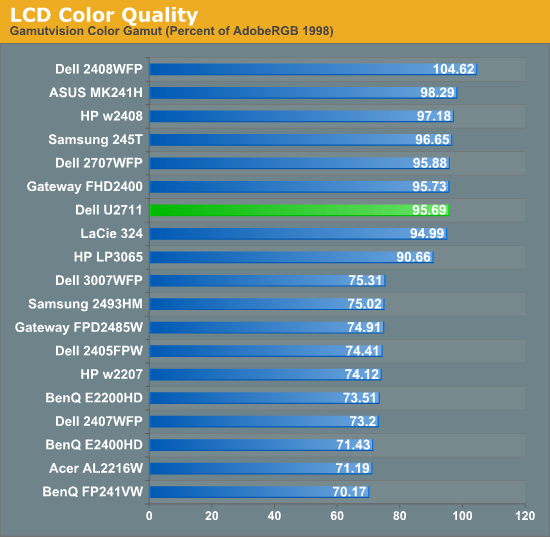
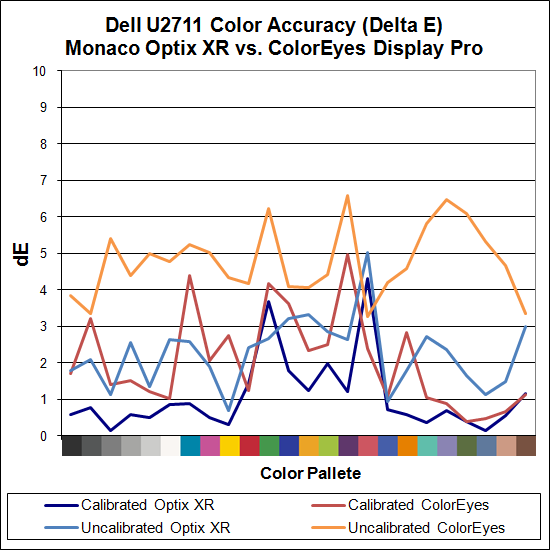
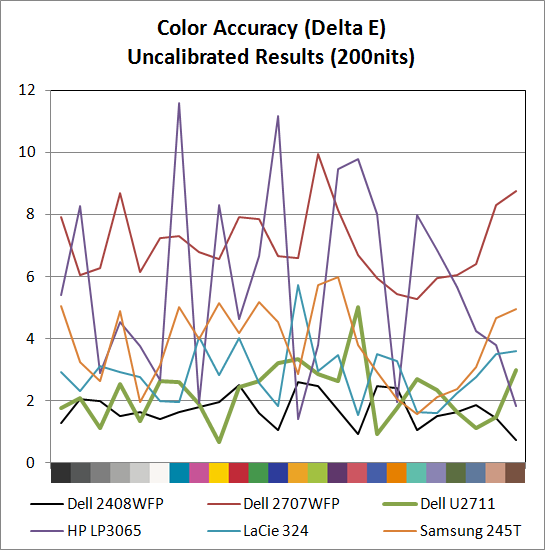
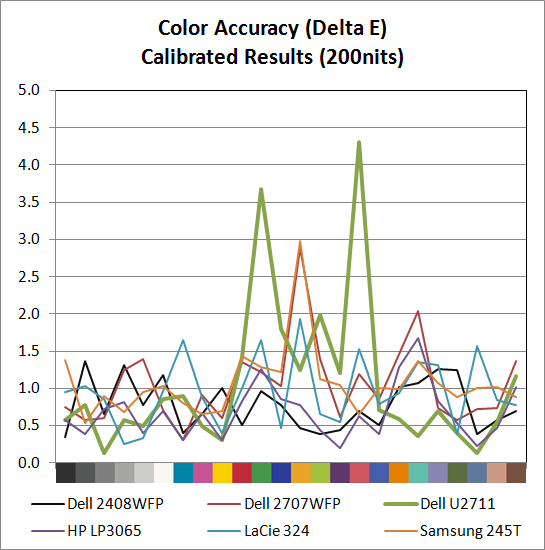
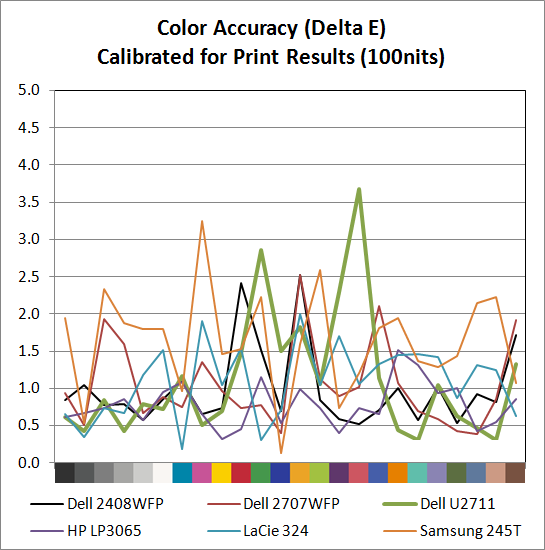
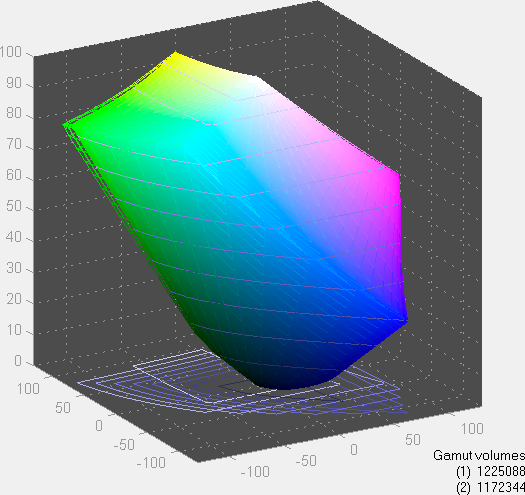
The U2711 scores extremely well in color gamut, and it achieves the 96% of Adobe RGB that Dell claims in their literature (not that most users would really notice the difference between any of the displays rated 90% to 105% - at least not after you eliminate the TN panels). Color accuracy on the other hand is a bit of a mixed bag. Dell ships a paper with test results showing the color calibration of each individual U2711, with the claim that the displays will have an average Delta E of less than 5.0 without any end-user calibration (when using the sRGB and Adobe RGB settings). Dell uses Minolta Color Analyzer CA210 and 32 test colors while we test with ColorEyes Display Pro and Monaco Optix XR Pro and 24 test colors, but our Monaco results confirm their claim. We're not sure why, but we continue to get better results using Optix XR Pro than with ColorEyes Display Pro.
As far as Optix is concerned, the U2711 achieves the rated Delta E of < 5.0 at just 2.24 without calibration, which is an excellent result. In fact the U2711 has no colors in the standard Gretag Macbeth 24 color palette score higher than 5.0 (and only reddish-pink scores a 5.0 measurement). The only LCD we've tested that did better is Dell's own 2408WFP (which also, interestingly enough, had an Adobe RGB color gamut of 105%). ColorEyes also gives an average Delta E of less than 5.0, but at 4.78 the score isn't nearly as remarkable, with nine color measurements well above 5.0. The uncalibrated (Monaco) results put the U2711 ahead of the HP LP3065, Dell 2707WFP, Samsung 245T, and LaCie 324 - and just about every other LCD we've tested.
Switch to the calibrated results and the U2711 doesn't impress quite as much relative to the competition. Monaco gives the U2711 an average Delta E of 1.06, which is great, but there are two results above 3.0 (the worst is reddish-pink again, this time at 4.31) compared to displays like the HP LP3065 where the highest measured Delta E is just 1.68. Dell's own 2707WFP, a three-year-old offering, also delivered a similar average Delta E but with only two colors above 2.0 (and still under 3.0). For a better LCD (i.e. not a TN panel), the results are really only slightly above average. It is possible different calibration software would achieve a better end result, but really we're talking about a "problem" that only the most demanding users are likely to ever notice.
Color Consistency
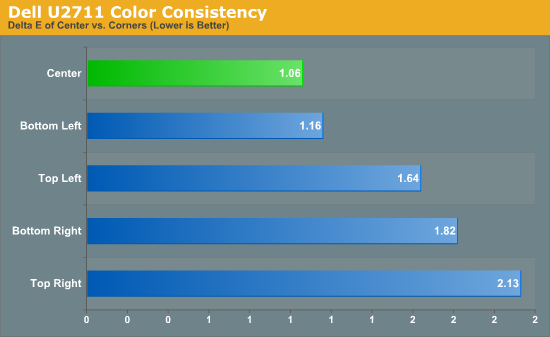
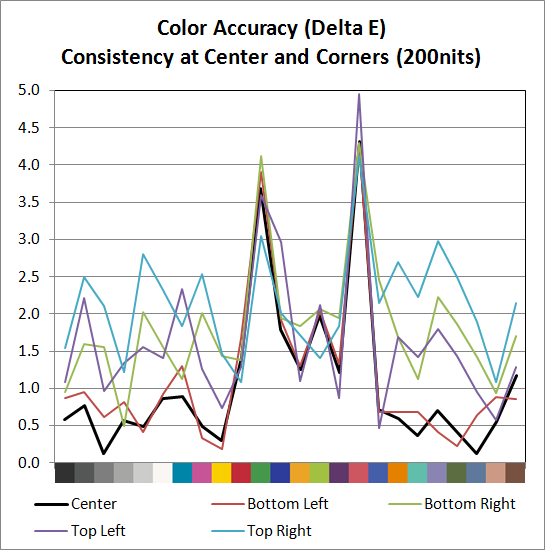
We added another test to try and measure the panel consistency across the entire surface. We measure Delta E at the center of the display, but what happens on the edges? To test this, we used the same profile generated in our best Delta E test result and measured Delta E again at the four corners. Most of the scores are similar, with a slight increase in average Delta E relative to the center measurement. The bottom-left corner is nearly identical to the center measurement, the top-left and bottom-right are a bit worse, and the top-right corner gets the overall worst result. While on the one hand we could say that the Delta E on the top-right is twice that of the center measurement, it's not a case of being "twice as bad". In fact, the color consistency is very good, and we didn't notice any "hot spots" are areas where the colors were clearly off relative to the rest of the LCD.










153 Comments
View All Comments
Lord 666 - Friday, January 22, 2010 - link
Where is the application form for writers/reviewers? I'm interestedJarredWalton - Friday, January 22, 2010 - link
It was posted by Anand a few weeks back... here's the link; I don't know if he's still sorting through and accepting submissions, but it can't hurt to try. :)http://www.anandtech.com/showdoc.aspx?i=3698">http://www.anandtech.com/showdoc.aspx?i=3698
ViRGE - Friday, January 22, 2010 - link
16x9? Boo!Mr Perfect - Friday, January 22, 2010 - link
Oh, hey, you're right.Why did Dell make this thing a 16:9? On what planet in this or any parallel universe is a 2560x1440 display more desirable then a 2560x1600 one? I can almost understand why they make 16:9 24" screens(Look it's 1080! Full HD! It must be the bestest resolution available!), but that doesn't apply here. Give us back the other 160 vertical pixels, please!
Griswold - Sunday, January 24, 2010 - link
Agreed. its a matter of marketing bullshit. 16:10 is going the way of the Dodo just because marketing monkeys like to yip-yap about "FULL HD" resolution despite inferiority in every way - its a sad, sad world.But its probably not Dell at fault there, but the panel maker(s) instead. You cant sell what you cant buy as a company like Dell.
AnnonymousCoward - Saturday, January 23, 2010 - link
I totally agree, and I hate 16:9.strikeback03 - Friday, January 22, 2010 - link
I'm gonna guess Apple was the one that paid some LCD maker to make a 2560x1440 panel, so Dell was stuck with that. Can't be a lot of options for these panels.Ph0b0s - Friday, January 22, 2010 - link
You need to explain in your reviews of high gamut displays the implications of getting one of thoes displays. Especially to your gaming audience.High gamut displays are not always a good thing. They are great for photo and video profesionals who use applictions that have color management (can covert to the high gamut color space). But for every other application and game where the assumption is that the display connected is a normal gamut one, the colors will be over exagerated or just wrong. The reds and greens will sear your eyes out. Now this my be ok with the other advantages of the monitor (small dot pitch, etc), but people should be given the negatives as well as the positives.
Hopefully all apps will become color managed at somepoint and this will no longer be an issue, but until then high gamut displays are bleeding edge. I expected better from anandtech.
CSMR - Friday, January 22, 2010 - link
Agree, it should be mentioned. Technically - aside from OS and software problems - more is better. But unfortunately I don't know of any video players that are color managed even on Windows 7. Same for games I guess. This can be fixed at the OS level but I don't think Windows 7 does that with all applications.Presumably there is a monitor setting for sRGB so if you are using non-color-managed software you can switch to it temporarily.
Ph0b0s - Friday, January 29, 2010 - link
A lot of Wide gamut displays have an sRGB emulation mode. But a lot of them are rubbish and don't realy do a good emulation. Seems to depend on whether hardware (lut ?) has been installed in the monitor or not. Maybe this should be part of the testing during the review to see if the sRGB emulation is any good or not. Since it is an expensive display reviewd above, then maybe the sRGB emulation is being done properly on this display....